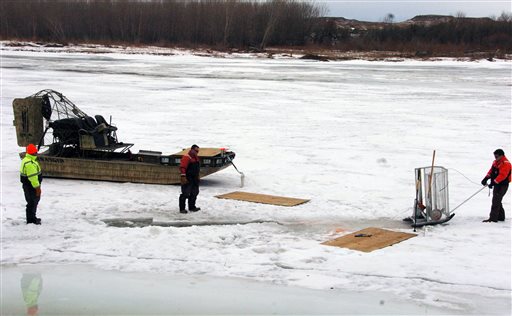January 2015, Vol. 242, No. 1
Projects
Poplar spill fueling worries about Dakota Access; replacement announced

SIOUX FALLS, S.D. (AP) — A pipeline oil spill in Montana that contaminated a river and a city’s drinking water supply is adding to fears about a proposed pipeline to carry oil from western North Dakota to a terminal in Illinois for distribution to refineries in eastern states.
Many people who commented Thursday at a public hearing in Sioux Falls, South Dakota, on the proposed $3.8 billion Dakota Access Pipeline referenced the Yellowstone River spill that contaminated drinking water in Glendive, Montana, this week. Some residents fear a similar incident could occur with the Dakota Access Pipeline.
“If the pipeline fails — and there are plenty of examples of these types of pipelines failing — and cleanup costs exceed what Dakota Access can pay, who is going to end up paying?” Aaron Johnson asked members of South Dakota’s Public Utilities Commission, which must approve a construction permit.
Some at the hearing voiced support for the project, citing a promised economic boost and the value of pipelines in pushing the country toward independence from foreign oil.
“This crude is being consumed by millions of people across the United States,” said Joe Chastain, who represents union workers in South Dakota.
The proposed 1,134-mile Dakota Access Pipeline would stretch from the Bakken oil formation in North Dakota to Patoka, Illinois. North Dakota’s Pipeline Authority has said it would be the largest-capacity pipeline for the state’s crude to date.

Dallas-based Energy Transfer Partners has said the pipeline will have numerous safety features, will create thousands of jobs and generate tens of millions of dollars in taxes and landowner easements. The company wants it operating by the end of 2016.
Meanwhile, the Poplar Pipeline section where the incident occurred will be completely replaced with a new line buried more deeply to protect against future accidents, Bridger Pipeline said.
The Jan. 17 spill into the Yellowstone River contaminated the water supply for 6,000 residents of Glendive in eastern Montana. The city’s water was certified safe to drink on Friday after tests showed it no longer had harmful levels of benzene, a cancer-causing component of crude.
The cause of the spill remains under investigation.
The Poplar Pipeline will stay shut down from Glendive to near the Canada border until the damaged section is replaced, said Bill Salvin, spokesman for owner Bridger Pipeline LLC.
The 340-mile line delivers crude from the Bakken oil patch of North Dakota and Montana to a terminal in Baker, Montana, about 55 miles south of Glendive. It was built in the 1950s and has a capacity of 42,000 barrels of oil a day.
The southern section of the line remains operational.
When it was first installed, workers dredged the river and laid the pipe across the bottom.
A 2012 inspection determined the line was buried at least 8 feet beneath the riverbed, according to Bridger Pipeline. In August of that year, federal regulators told Montana authorities that the line had “adequate cover.”
But prior accidents, including a 2011 Exxon Mobil pipeline spill on the Yellowstone near Billings, have demonstrated that pipelines beneath bodies of water can quickly become exposed by floodwaters or other natural forces.
Officials haven’t been able to say if the Poplar line was similarly exposed. Much of the Yellowstone is covered with thick ice that prevents direct access to the line and has complicated cleanup efforts.
One factor investigators will consider is whether a massive ice jam in early 2014, which local residents say blocked the Yellowstone near the site of the pipeline breach, could have previously damaged the line.
To install its new section of pipeline, Bridger Pipeline would use a technique known as directional drilling — a process in which lines are drilled sometimes dozens of feet beneath a river through solid rock or other material considered more stable than the constantly shifting riverbed.
The timing and cost of replacing the river crossing was not yet known.
Cleanup crews on Thursday recovered another 34 barrels of oil from the damaged section of line. That’s equivalent to about 1,400 gallons and reduces the amount believed to have entered the Yellowstone to roughly 39,000 gallons, Salvin said.
Bridger Pipeline is a subsidiary of True Cos.
A sister company operating in Wyoming, Belle Fourche Pipeline, had three oil spills within a month in 2014 totaling more than 100,000 gallons of crude. Those spills included a malfunction that caused an oil storage tank to overflow and spill 70,000 gallons, a 25,000-gallon spill from a corroded section of pipeline, and a 9,000 gallon spill when heavy equipment damaged one of the company’s pipelines.
Copyright 2015 The Associated Press. All rights reserved. This material may not be published, broadcast, rewritten or redistributed.





Comments